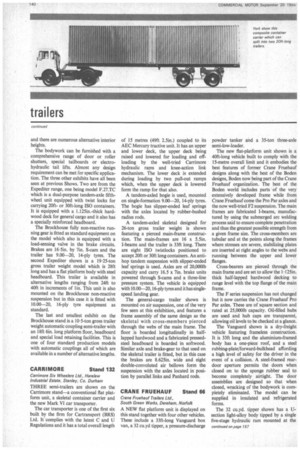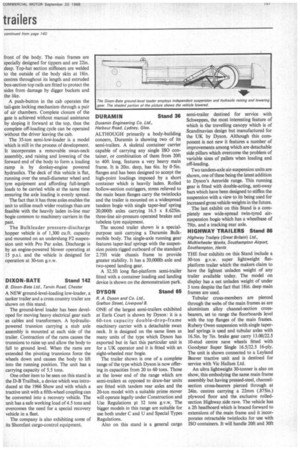CRANE FRUEHAUF Stand 66
Page 144

Page 161

If you've noticed an error in this article please click here to report it so we can fix it.
Crane Fruehauf Trailers Ltd., South Green Works, Dereham, Norfolk
A NEW flat platform unit is displayed on this stand together with four other vehicles. These include a 33ft-long Vanguard box van, a 32 cu.yd tipper, a pressure-discharge powder tanker and a 35-ton three-axle semi-low-loader.
The new flat-platform unit shown is a 40ft-long vehicle built to comply with the 15-metre overall limit and it embodies the best features of former Crane Fruehauf designs along with the best of the Boden designs, Boden now being part of the Crane Fruehauf organization. The best of the Boden world includes parts of the very extensively developed frame while from Crane Fruehauf come the Pro Par axles and the now well-tried F2 suspension. The main frames are fabricated 1-beams, manufactured by using the submerged arc welding process said to ensure complete penetration and thus the greatest possible strength from a given frame size. The cross-members are tubular and at the points along the frames where stresses are severe, stabilizing plates are inserted at right angles to the webs and running between the upper and lower flanges.
Cross-bearers are pierced through the main frame and are set to allow the 1.125in. thick half-lapped hardwood decking to range level with the top flange of the main frame.
The F series suspension has not changed but it now carries the Crane Fruehauf Pro Par axles. These are of square section and rated at 25,0001b capacity. Oil-filled hubs are used and hub caps are transparent, allowing oil levels to be checked at a glance.
The Vanguard shown is a dry-freight vehicle featuring frameless construction. It is 33ft long and the aluminium-framed body has a one-piece roof, and a steel rubbing-plate/forward-bulkhead affording a high level of safety for the driver in the event of a collision. A steel-framed reardoor aperture permits the doors when closed on to the sponge rubber seal to become completely airtight. The door assemblies are designed so that when closed, wracking of the bodywork is completely eliminated. The model can be supplied in insulated and refrigerated forms.
The 32 cu.yd. tipper shown has a Usection light-alloy body tipped by a single five-stage hydraulic ram mounted at the front of the body. The main frames are specially designed for tippers and are 22in. deep. Top-hat section stiffeners are welded to the outside of the body skin at 18in. centres throughout its length and extruded box-section top rails are fitted to protect the sides from damage by digger buckets and the like.
A push-button in the cab operates the tail-gate locking mechanism through a pair of air chambers. Complete closure of the gate is achieved without manual assistance by sloping it forward at the top, thus the complete off-loading cycle can be operated without the driver leaving the cab.
The 35-ton semi-low-loader is a model which is still in the process of development. It incorporates a removable swan-neck assembly, and raising and lowering of the forward end of the body to form a loading ramp is by donkey-engine powered hydraulics. The deck of this vehicle is flat, running over the small-diameter wheel and tyre equipment and affording full-length loads to be carried while at the same time ensuring the axle loading is evenly spread.
The fact that it has three axles enables the unit to utilize much wider routings than are feasible with the heavily laden in-line rear bogie common to machinery carriers in the past.
The Bulkleader pressure-discharge hopper vehicle is of 1,300 cu.ft. capacity and mounted on an underslung F2 suspension unit with Pro Par axles. Discharge is by an engine-powered blower operating at 15 p.s.i. and the vehicle is designed for operation at 30-ton g.v.w.


















































































































































































































































































































































































